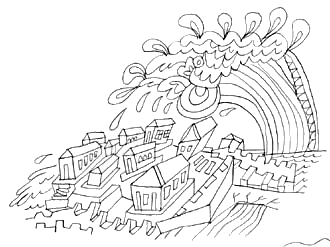 | |
| { The Loudest Sound Ever Heard } Devon W. Thompson illustration by Alex Smith
The force of the eruption of Krakatoa was powerful enough to disrupt the fabric of space and time, throwing into the future an endless array of information, from shards of secondhand anecdotal evidence, to fully realized scientific studies, astonishing in their metamorphic density. The amateur archaeologist, with persistence and a little luck, can still to this day find the occasional fragment lodged in modern tomes and journals, just below the topsoil. The story you're now reading was unearthed in Provo, Utah, in 1906. Word of its discovery traveled rapidly across the expanding nation, sparking the interest of Pittsburgh steel magnate Andrew Carnegie, who demanded immediate acquisition of the relic for display in his namesake natural history museum, opened only three years prior. Cost was no factor to the burgeoning philanthropist, who knew that the tale would draw endless crowds and be the envy of museums the world over. Carnegie dispatched by train twenty of his best men, in black leather trenchcoats with two sidearms each, and in seven days they returned with the story, still partially embedded in sandstone and wrapped in woolen blankets. It weighed fourteen tons. | |
 Prior to 27 August 1883, if you were traveling on one of the many trading ships passing through the Sunda Strait between the Indonesian islands of Sumatra and Java, one of the landmarks certain to direct your route would be the modest island of Krakatoa. Steering your cargo of textiles and rare foods to and from exotic ports of the Far East you would likely give scant notice to its lush slopes and meandering beaches, for the island had made little effort to draw attention to itself in the past several centuries. But this morning would be different, as the long dormant volcanic isle, once thought by many to be extinct, roared to life with an unparalleled ferocity, destroying itself in the process, and sending shockwaves round the world. It produced what is commonly believed to be the loudest sound in recorded human history.
Prior to 27 August 1883, if you were traveling on one of the many trading ships passing through the Sunda Strait between the Indonesian islands of Sumatra and Java, one of the landmarks certain to direct your route would be the modest island of Krakatoa. Steering your cargo of textiles and rare foods to and from exotic ports of the Far East you would likely give scant notice to its lush slopes and meandering beaches, for the island had made little effort to draw attention to itself in the past several centuries. But this morning would be different, as the long dormant volcanic isle, once thought by many to be extinct, roared to life with an unparalleled ferocity, destroying itself in the process, and sending shockwaves round the world. It produced what is commonly believed to be the loudest sound in recorded human history.